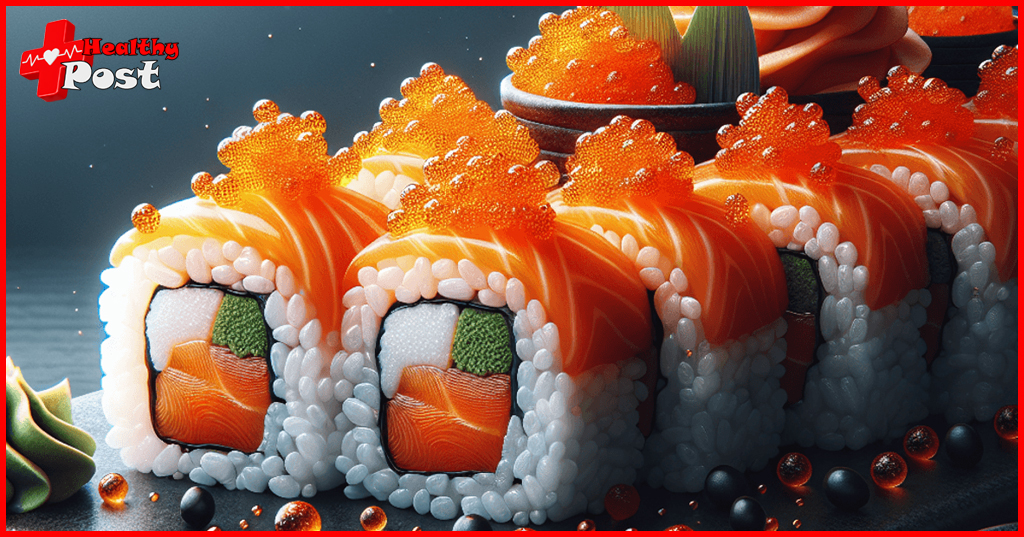
What Is Masago and Its Benefits? A Complete Guide
Masago, a popular ingredient in Asian cuisine and sushi rolls, is more than just a garnish that adds a burst of color and flavor to dishes. These small, orange fish eggs are obtained from the capelin fish and have become a beloved addition to various culinary creations.
In this article, we will explore:
- The nutritional profile of masago
- Its potential health benefits
- Any risks or concerns associated with its consumption
This will ensure you have all the information you need to make informed choices about incorporating masago into your diet.

What is Masago?
Masago is the edible eggs of the capelin fish, a type of smelt roe that is commonly used in Asian cuisine and particularly popular in sushi preparation. These small, orange fish eggs are prized for their vibrant color and delicate texture, adding both visual appeal and a burst of flavor to various dishes.
Appearance and Size
Masago eggs are smaller compared to other types of fish roe, such as tobiko. Their small size gives them a unique texture that pops with a slight crunch when eaten.
Color Distinction
The vibrant orange color of masago is natural, unlike tobiko which can be colored using different flavorings or marinades. This makes masago easily recognizable when used in cooking.
Taste Profile
Masago has a mild and slightly sweet flavor that goes well with many ingredients. Its subtle taste allows it to enhance the natural flavors of other elements without overpowering them.
The Nutritional Value of Masago
Masago is not only a flavorful addition to sushi rolls and other Asian dishes, but it also packs a nutritional punch. Let’s take a closer look at the key nutrients found in masago and their role in supporting overall health and well-being:
1. Omega-3 Fatty Acids
Masago is a rich source of omega-3 fatty acids, which are essential fats that our bodies can’t produce on their own. These healthy fats have been linked to numerous health benefits, including reducing inflammation, improving heart health, and supporting brain function.
2. Vitamin B12
Masago is an excellent source of vitamin B12, a nutrient that plays a crucial role in energy production, DNA synthesis, and maintaining healthy nerve cells. Adequate intake of vitamin B12 is essential for optimal brain function and preventing certain types of anemia.
3. Protein
Masago is packed with protein, making it an excellent choice for individuals looking to increase their protein intake. Protein is essential for repairing tissues, building muscle mass, and supporting a healthy immune system.
4. Selenium
Masago contains selenium, a mineral with antioxidant properties. Selenium helps protect our cells from damage caused by free radicals and may have potential anti-cancer effects. It also plays a vital role in thyroid function and supporting a healthy immune system.
Including masago in your diet can provide you with these important nutrients that contribute to your overall well-being. However, it’s important to keep in mind that moderation is key because masago is also high in sodium content.
Now that we’ve explored the nutritional value of masago, let’s delve into the potential health benefits it may offer when consumed as part of a balanced diet.
Potential Health Benefits
While there isn’t much research specifically on the health benefits of masago, its nutrient-rich makeup suggests that it may have some advantages when eaten as part of a balanced diet. Here are some potential benefits supported by the properties of its key nutrients:
- Omega-3 Fatty Acids for Heart Health: Masago is packed with omega-3 fatty acids, which are essential fats that have been linked to various heart health benefits. These fatty acids have been shown to reduce inflammation, lower triglyceride levels, and improve overall cardiovascular health.
- Vitamin B12 for Energy Production and Brain Function: Masago is a good source of vitamin B12, a nutrient necessary for energy production and the proper functioning of the brain and nervous system. Getting enough vitamin B12 can help prevent fatigue, support cognitive function, and maintain healthy nerve cells.
- Protein for Muscle Repair and Growth: Masago has quite a bit of protein, which is crucial for fixing and building muscles. Protein also plays a role in making enzymes, regulating hormones, and supporting the immune system.
- Selenium as an Antioxidant with Potential Anti-Cancer Effects: It naturally contains selenium, a strong antioxidant that helps shield cells from damage caused by harmful molecules called free radicals. Selenium has been linked to a lower risk of certain types of cancer and is important for maintaining a healthy immune system.
It’s worth noting that while masago might have these potential health benefits, it’s best to include it as part of an overall nutritious diet instead of relying solely on it for your nutritional needs. Eating a variety of foods that are rich in nutrients will give you a wider range of health advantages.
“Adding masago to your meals can be a tasty way to increase your intake of omega-3 fatty acids, vitamin B12, protein, and selenium.”
Risks and Considerations
Despite its nutritional benefits, it is not without its risks and concerns. It’s important to be aware of the following:
- Possible adverse effects of excessive masago consumption: While it can be a healthy addition to your diet, consuming it in excess may lead to increased sodium intake. This can be problematic for individuals with high blood pressure or those who are on a low-sodium diet. It’s essential to moderate your masago intake and balance it with other low-sodium foods.
- Potential harm to individuals with seafood allergies: It is derived from fish, which means it can trigger allergic reactions in individuals with seafood allergies. If you have a known allergy, it’s crucial to avoid consuming masago or any other fish roe to prevent adverse reactions such as itching, hives, or even anaphylaxis.
- The issue of mercury contamination: Mercury is a heavy metal that can accumulate in certain seafood products due to pollution. However, compared to larger fish species like tuna or swordfish, it is generally considered low in mercury. Nonetheless, if you are pregnant or have specific concerns about mercury exposure, it’s best to consult with your healthcare provider before including masago in your diet.
- Sustainability issues related to capelin fish harvesting: Capelin fish are harvested for their roe, including masago. However, there are concerns about the sustainability of capelin fishing practices. Overfishing and targeting egg-bearing female capelins for masago production can have negative impacts on capelin populations and the marine ecosystem. To support environmental sustainability, it’s important to choose responsibly sourced masago from reputable suppliers who follow sustainable fishing practices.
Balanced diet
By being mindful of these risks and considerations, you can enjoy it as part of a balanced diet while minimizing potential negative effects. Moderation is key when incorporating masago into your meals, and considering alternatives for individuals with seafood allergies is important for their safety and well-being. Additionally, supporting sustainable sourcing practices helps protect the environment and ensure the long-term availability of masago as a culinary delight.

Incorporating Masago into Your Meals
When it comes to using it in your cooking, the possibilities are endless. This delicate and flavorful ingredient can enhance a wide range of dishes, adding a burst of savory taste and vibrant color. Here are some practical tips and creative recipe ideas to inspire your culinary adventures with masago:
1. Sushi Rolls
Of course, it is a staple in traditional sushi rolls, adding a pop of color and briny flavor. Consider using it in homemade sushi rolls for an authentic touch.
2. Sushi Bowls
Create deconstructed sushi bowls by sprinkling it over a bed of sushi rice or mixed greens, along with your favorite sushi ingredients. The masago will provide a delightful contrast in texture and taste.
3. Seafood Pasta
Enhance the flavor of seafood pasta dishes by mixing it into the sauce or using it as a garnish. Its subtle saltiness pairs beautifully with the natural sweetness of shellfish.
4. Avocado Toast
Elevate your avocado toast game by sprinkling a generous pinch of masago on top. The combination of creamy avocado and crunchy masago creates a delightful sensory experience.
5. Salads
Add a unique twist to salads by using it as a flavorful topping. Its small, colorful beads will not only enhance the visual appeal but also contribute a burst of taste.
6. Omelets and Scrambled Eggs
For a luxurious breakfast or brunch option, fold masago into omelets or sprinkle it over scrambled eggs for an unexpected burst of briny goodness.
By trying out these culinary ideas, you can discover new ways to enjoy it beyond its usual role in sushi. Don’t be afraid to get creative in the kitchen and let the distinct flavor and texture of masago inspire your cooking!
Enjoy Masago Responsibly
When it comes to enjoying it, the key is moderation and mindfulness. While it offers impressive nutritional benefits, it’s essential to consider personal factors and potential risks. Here are some final thoughts on savoring masago responsibly:
- Moderation is Key: Embracing a balanced approach to consuming masago ensures that you can relish its flavors and nutrients without overdoing it.
- Allergy Risk Awareness: Individuals with seafood allergies should exercise caution and consult with a healthcare professional before incorporating it into their diet.
- Personal Considerations: Take into account your dietary preferences, health goals, and any specific concerns you may have when including it in your meals.
By savoring masago responsibly, you can delight in its culinary delights while making informed choices that align with your well-being. Whether adding a pop of color to your sushi creations or experimenting with innovative recipes, embracing mindful enjoyment ensures a fulfilling experience with this delectable ingredient.

